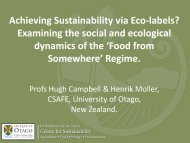Book of Abstract (incl. addendum) - IFSA symposium 2012
Book of Abstract (incl. addendum) - IFSA symposium 2012
Book of Abstract (incl. addendum) - IFSA symposium 2012
Create successful ePaper yourself
Turn your PDF publications into a flip-book with our unique Google optimized e-Paper software.
Workshop 5.1 The landscape as the basis for integrating different levels <strong>of</strong> management,<br />
policy making and other dimensions <strong>of</strong> the rural<br />
important habitats favourable to the occurrence <strong>of</strong> fish species <strong>of</strong> economic and/or conservation value<br />
and several important bird species and mammals. These characteristics together with a high<br />
attractiveness <strong>of</strong> its surrounding mountains and scattered scenic settlements provide rural endogenous<br />
development potentials in which ecological and economic progress might go hand in hand. Sustainable<br />
development potential however is constrained at the landscape level where contemporary rural policy<br />
making is largely absent. In this paper we analyse the multiple dimensions that shape the Minho Delta<br />
as rural space, and explore its ‘optimal’ socio-ecological configuration. This might serve as ‘Leitbild’<br />
for the organization and the implementation <strong>of</strong> a new institutional level. We think this landscape based<br />
approach will result in the incorporation <strong>of</strong> stakeholders in the region and in the negotiation <strong>of</strong><br />
interests, which if carefully managed results in strengthening the socio-ecological and economic<br />
performance <strong>of</strong> the rural region <strong>of</strong> the Minho Delta as a whole.<br />
High Nature Value Farming Systems classification: A landscape -based<br />
approach<br />
Mara Almeida and Teresa Pinto-Correia<br />
University <strong>of</strong> Èvora, Portugal<br />
Mdsa@uevora.pt<br />
The High Nature Value (HNV) classification <strong>of</strong> farm systems, proposed by the European Environment<br />
Agency, emerges as more relevant today in the preparation <strong>of</strong> rural development programme within the<br />
CAP post-2013. HNV classification is applicable across all Europe and seeks to define objective<br />
criteria for identifying farm systems that support high biodiversity values and landscape quality, which<br />
may also be linked to other ecosystem services. Considering that changes in rural space, taking place<br />
across all Europe, have been occurring at different levels, paces and intensities, the assessment <strong>of</strong> HNV<br />
farm systems also needs to consider this differentiation. Spatially based approaches at the regional<br />
level, linked to landscape based indicators, may be the way forward to reliable information, required<br />
for the contemporary rural policy making. This presentation is based on a case study in Alentejo region<br />
in south Portugal dominated by traditionally managed agro-forestry systems which allow maintaining<br />
the specific character <strong>of</strong> these landscapes and have created conditions for establishing other functions<br />
(nature conservation, recreation, etc.). These traditional extensive practices have a great impact on<br />
vegetation composition, species distribution and landscape pattern and consequently they influence<br />
landscape quality and attractiveness for recreational activities. Therefore, this close relationship<br />
between farming practices and landscape patterns led us to seek what defines a HNV farm system in<br />
the Alentejo context and to identify its distribution considering landscape as the basis for a spatial<br />
approach. Recognizing the diversity <strong>of</strong> farm system types, and aiming to identify the associated<br />
landscape patterns and relate them with the HNV classification, the proposed presentation will focus on<br />
the methodological approach, grounded in preliminary field work, and the consequent development <strong>of</strong><br />
the landscape based HNV indicators, applicable to Alentejo.<br />
Methodological approach to create indicators contributing to measure<br />
effects <strong>of</strong> policies in rural areas - Case study in Alentejo, South Portugal<br />
Luis Carlos Madeira, Sónia Carvalho Ribeiro and Teresa Pinto-Correia<br />
University <strong>of</strong> Évora, Portugal<br />
Lmadeira@uevora.pt<br />
Previous work has been highlighting a close relationship between landscape characteristics and socioeconomic<br />
development. On one side, landscape contains economic value that can manifest itself<br />
through the implementation <strong>of</strong> certain economic activities. On the other side, the process <strong>of</strong> economic<br />
development frames landscape composition and configuration.<br />
84











